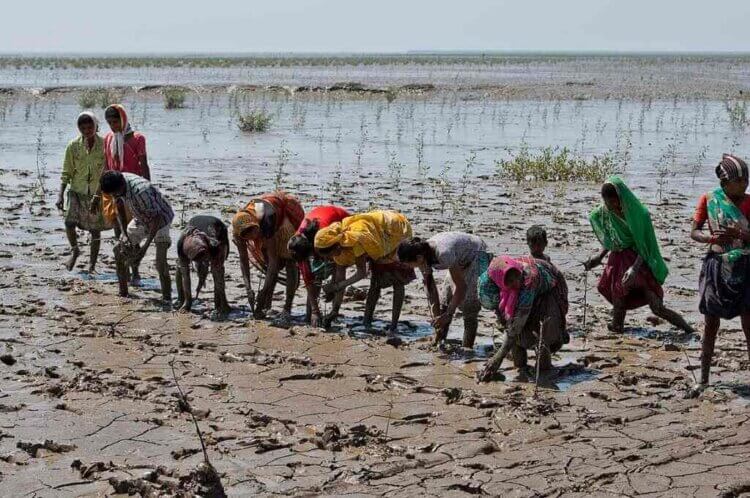Mitigating climate change and adapting to it requires not mass climate action but climate action by the masses. However, the current climate narrative is locking out common people. We are complicating the crisis by using so much jargon. The people who need to act on sustainability and adaptation locally should be able to understand it in simple terms.
Focus on people and livelihood
Long-term improvement in the environment and development of natural resources should also ensure short-term employment and medium-term income for a community affected by ecological degradation. With this in mind, we started work on wasteland development and mangrove plantations in Jambusar taluka. The community gathered to plant Prosopis juliflora, a cactus-like shrub that absorbs salinity from the soil and improves its quality. This project generated short-term employment because plantation work is labor-intensive. The model was clear: The lives of the people were at the center of the developmental effort and plantations were the means. It is critical to keep this focus.
A businessman, while appreciating our effort to restore coastal natural resources, inquired whether local people would contribute to the project with voluntary work. The people we work with are very poor and directly suffer the consequences of harsh climatic conditions and the degradation of natural resources. They do not have the financial resources to make such a sacrifice. Further, they are not responsible for the crisis. Those who have contributed to the crisis should shoulder the responsibility of restoring the balance. We need to change our perspective.
Engage with decision-makers
Business leaders and opinion makers will have to engage with the issue of restoring ecological balance—not just for the security of the local communities but also of their own businesses.
Before setting up extractive operations, those in decision-making positions should acknowledge the linkage between development and sustainability.
Gujarat has a 1,600 km coastline, the largest in the country. In the past 20 years, industry and the state have been in a race for natural resources in the area. Gujarat now has 42 ports. The Saurashtra belt is spotted with cement factories because of the large deposits of limestone here. Gas and energy from the Gujarat coast serve the whole of North India. The coastal belt holds much opportunity for economic growth. However, while pursuing this growth, we need to consider its consequences on the natural resources, the overall ecology, and coastal communities. Poverty in many coastal regions is closely linked with a community’s vulnerability to the changing climate. Those owning and running industries are often impervious to this impact, while local communities bear the brunt of their decisions.
Before setting up extractive operations, those in decision-making positions—businesses and policymakers—should acknowledge the linkage between economic development and environmental sustainability. As we center conversations on rebalancing the ecology, those in positions of power, such as industry bodies and governments, will have to reorient their work to the evolving climatic condition. Environmental development demands greater attention and investment of effort and resources from business and the state.
Empower communities to mobilize
It is critical to center this narrative on how communities define and articulate their experiences on the ground. We need to listen carefully when communities express what they are facing and build from these findings. The people affected by the changes should be the ones empowered to take decisions on them. Marginalized communities, especially women, should be enabled to take the lead on environmental work.
A community’s strength lies in its numbers. When they aggregate themselves and assert what they want, they wield power and civil society organizations (CSOs) can help them mobilize in this manner. In 1992, approximately 3,000 people from the villages in the area we worked in organized a rally demanding wasteland to be handed over to them under the Rural Land Ceiling Act. As a result, the government transferred 1,400 acres of wasteland to nine cooperative societies comprising 440 agricultural laborer’s. Another 1,600 acres of surplus land was transferred to agricultural laborer’s, and 21 ponds were given to them on lease for fishing. We then helped develop these resources with the community and community-led organizations such as Panchayati Raj institutions and self-helps groups.
Over time, they have planted approximately 6 million trees across 2,000 hectares of mangroves. The advantages are already clear. When cyclone Biparjoy struck earlier this year, the damage on land covered by these trees felt was less.
Don’t romanticise traditional wisdom
People’s traditional knowledge of the landscape is critical but so are scientific tools and know-how from experts. In 2007, in the Little Rann of Kachchh, we learned that when salt pan workers (or Agariyas) die, their feet are cut off before the cremation. Their feet don’t burn because of the salt they retain by working long hours in saline water. Seven to eight thousand families are employed in these salt pans. Despite this physical labor, which generates 15 percent of India’s total inland salt, the community earned only 1 percent of the final market value of the salt.
If I consumed salt for approximately INR 20 per kg, they got 8 paisa per kg of raw salt. We explored why this was happening. Annually, between October and May—for about eight months—they pumped out water that needed diesel pumps. The cost of diesel for this endeavor was approximately 70 percent of their final production cost. Farmers borrowed money from traders on high interest for these pumps. To break their debt cycle, we explored ideas on how to replace the diesel pumps. We realized that solar-power-based pumps would not only be more cost-effective but also more environmentally friendly. We approached NABARD to help us design solar-powered pumps. Between 2016 and 2022, approximately 3,800 solar pumps have been installed with 80 percent subsidy from the government. This shift for more sustainability has also altered the socio-economic fabric of the entire community in the area.
So, as nonprofits, we have the responsibility to bring technological and other resources required for some of the changes. The communities do not have all the expertise they need. While solving complex developmental and environmental challenges, equal weightage should be given to scientific expertise and traditional knowledge.
Stay small, agile, and creative
Nonprofits occupy a unique space as facilitators in the development ecosystem. Some of the toughest, most complex problems in the sector need creativity and enterprise. Staying small affords us the advantage of being flexible and enables us to take risks that larger bodies, such as the government and industry, may not be able to take. There is a strategy in remaining small and effective, especially with sustainability, which calls for decentralized and hyperlocal action.
We need to build models and solutions that can be picked up, multiplied, and scaled by other stakeholders.
However, many organizations have slowly been moving away from playing the role of facilitators and moving towards performing what ought to be the government’s role. Some have almost become corporations. When this happens, nonprofits become focused on their own organizational goals and preoccupied with managing their own resources.
To my mind, a nonprofit’s role is one of research and development (R&D). We need to build models and solutions that can be picked up, multiplied, and scaled by other stakeholders.
Work with all stakeholders
While we can only start small, large-scale ecological work cannot be done in silos. CSOs with effective models should facilitate linkages between the communities and resource institutions, knowledge institutions, financial resources, and the state. It is the need of the hour that all stakeholders join forces.
There is no going back on the issue of climate change. This awareness should cut across all sectors. It should also take center stage in all kinds of work being done in the social sector. Staying focused on this challenge is not a choice any more, it’s a compulsion.








 Finance
Finance






